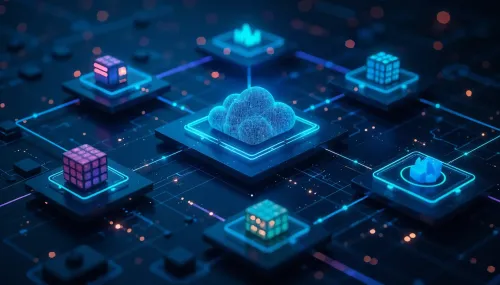

Legacy Application Modernization: A Path to Innovation, Agility, and Cost Savings






According to an IDC report, most legacy applications are expected to be modernized by 2024, and 65% will use cloud services to extend features or update code. The modernization of legacy systems will remain a prominent trend in 2024. Organizations that effectively manage the performance of their strategic or core business applications are likely to gain a competitive advantage and differentiate themselves.
However, outdated systems can hamper the team’s efficiency and achieving business objectives. Though legacy modernization might appear expensive, delaying the process makes it more complex, costly, and resource-intensive. Investing in a modernization strategy is worthwhile in the long run, but making informed decisions and developing a well-planned IT strategy is crucial.
Legacy modernization can contribute to increased business effectiveness, improved customer satisfaction, and sustained competitive position in the constantly changing digital environment. Proper planning for implementing a modernization process guarantees the success of the organizational development and avoids future threats to the organization.
This article explores the significance of transforming legacy applications and the actions needed to complete this process.
A legacy application is obsolete computing software and/or hardware that is still in operation. It still fulfills the requirements initially devised for but doesn’t permit expansion. A legacy application can only fulfill the originally designed functions and is unlikely to meet new or evolving business needs without substantial updates or replacements.
Legacy apps are often coded with an anachronistic approach, sometimes without documentation and related clarity. This ultimately causes the knowledge silos, thus posing a problem for the organization when the employees leave. The individuals who inherit the code may encounter difficulties understanding it, which can hinder progress and complicate the implementation of changes.
Legacy apps have the following characteristics:
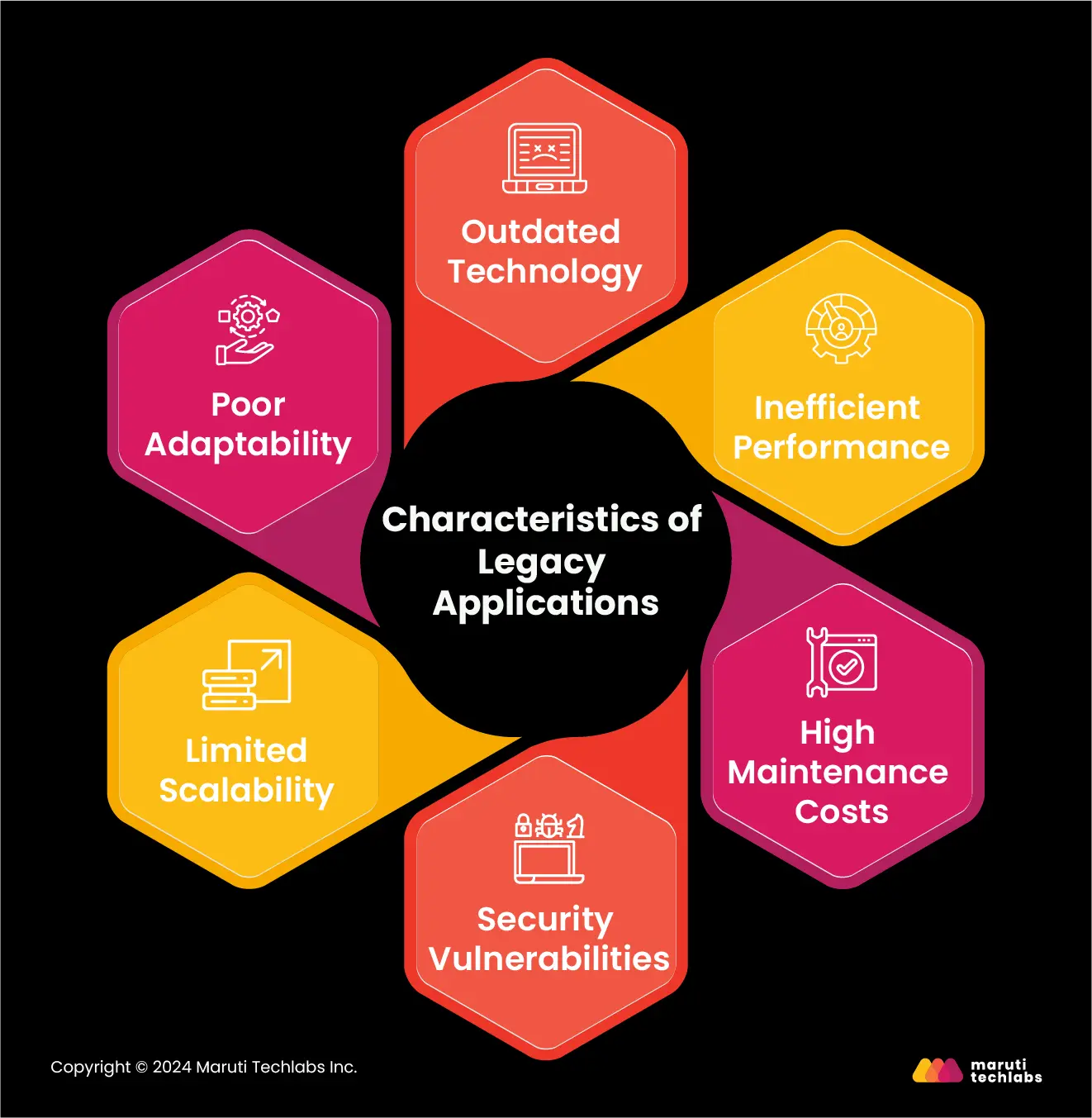
Outdated Technology: Legacy applications rely on outdated technology, developed using tools and systems that are no longer in use. Such outdated technologies impede the acceptance of modern standards and best practices.
Inefficient Performance: These applications are prone to inefficiency and slow response times that affect productivity.
Security Vulnerabilities: Legacy applications are prone to cybersecurity threats due to outdated security measures and updates.
High Maintenance Costs: The maintenance and support of legacy systems increase the costs over time.
Limited Scalability: Enhancing these systems is difficult and expensive due to high demands.
Poor Adaptability: Legacy systems struggle to meet modern business needs and dynamic changes.
Choosing the right time to update outdated applications can be challenging. There are a few signs that your business needs to go through the legacy modernization process. The right time for modernizing legacy applications can be when:
If you encounter any of these signs in your legacy system, it’s time to consider application modernization. Legacy systems are familiar, reliable havens. However, if your outdated technology displays the warning signs outlined earlier, it’s time to consider seeking modernization services.
Modernization of legacy applications brings numerous advantages to organizations that are aiming to be competitive and effective:
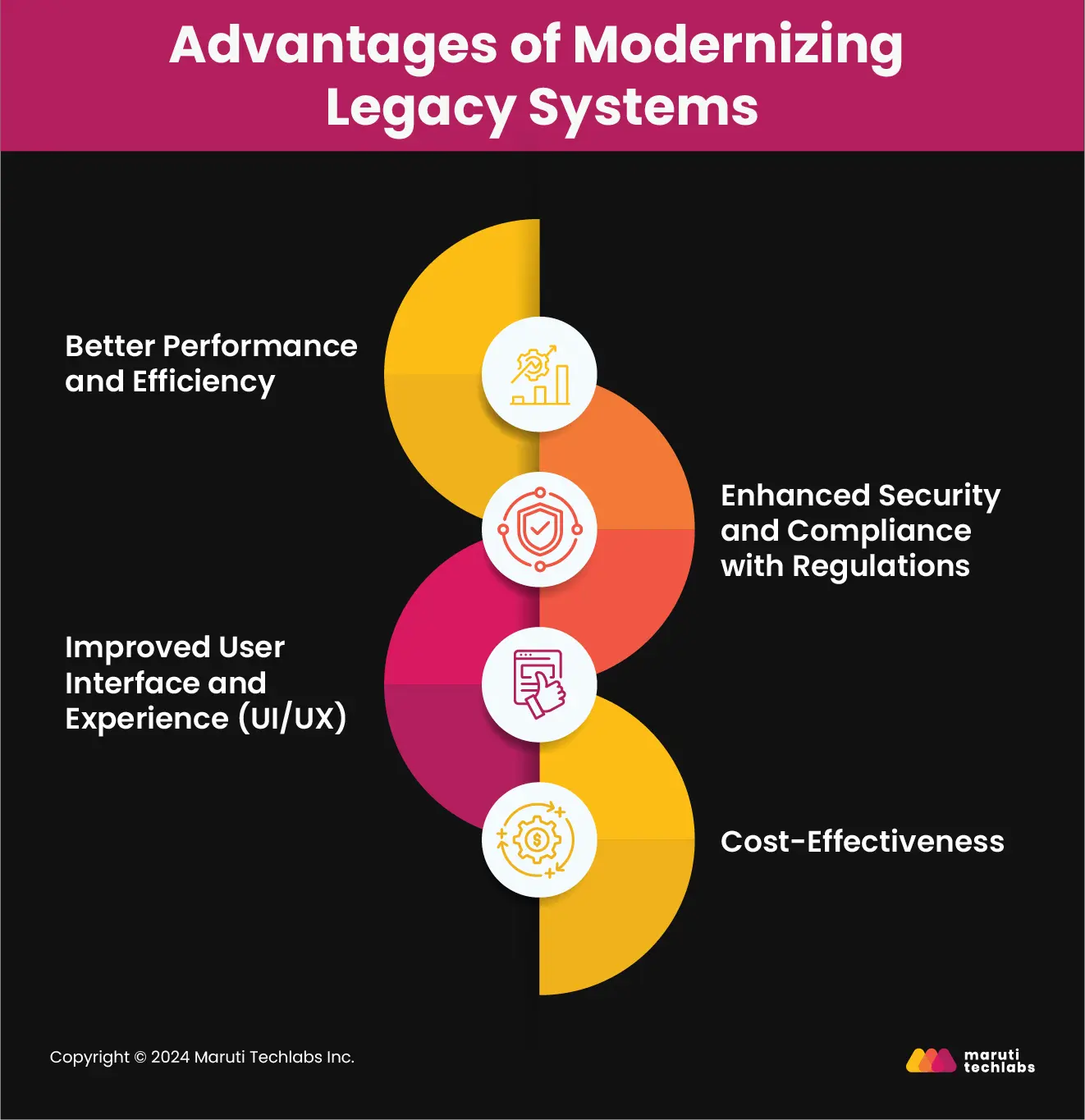
Legacy modernization can significantly improve operational processes’ effectiveness and productivity, improving user experience.
Modernization processes involve enhancing safety and setting up security measures that align with current industry standards. Therefore, they eliminate the possibility of leaked confidential information and fix the money loss issues due to non-compliance.
Modernization often involves renovating the UI and improving the UX, which raises employee and consumer satisfaction levels.
Through legacy modernization, businesses can reduce maintenance expenses, optimize hosting, and more effectively use a worldwide workforce, leading to significant long-term cost savings.
Think of your old computer system as a vintage car—reliable, classic, yet aged. Modernizing it is like upgrading your care and making it a more efficient, high-tech model.
To simplify any upgrade, you need a solid plan. That's where an app modernization strategy is useful. It is like a roadmap that leads you through the process, from adopting microservices architecture to updating your old software. Microservices are like building blocks for your modernization project. It breaks down your legacy system into smaller and manageable parts so that the legacy system is easier to handle and maintain.
Legacy modernization can be considered part of a large-scale digital transformation. It involves using digital tools to improve business operations, make them more efficient, and give customers a better experience.
Revamping old applications opens doors to agility! Businesses aim to keep pace with evolving customer demands and remain competitive by modernizing their applications. This involves upgrading and optimizing existing applications to improve efficiency, expandability, and user-friendliness. A booming application modernization initiative should yield various advantages, and it will be your responsibility to pursue the most significant or valuable advantages for your application. However, you need to consider a few questions before commencing a modernization project:
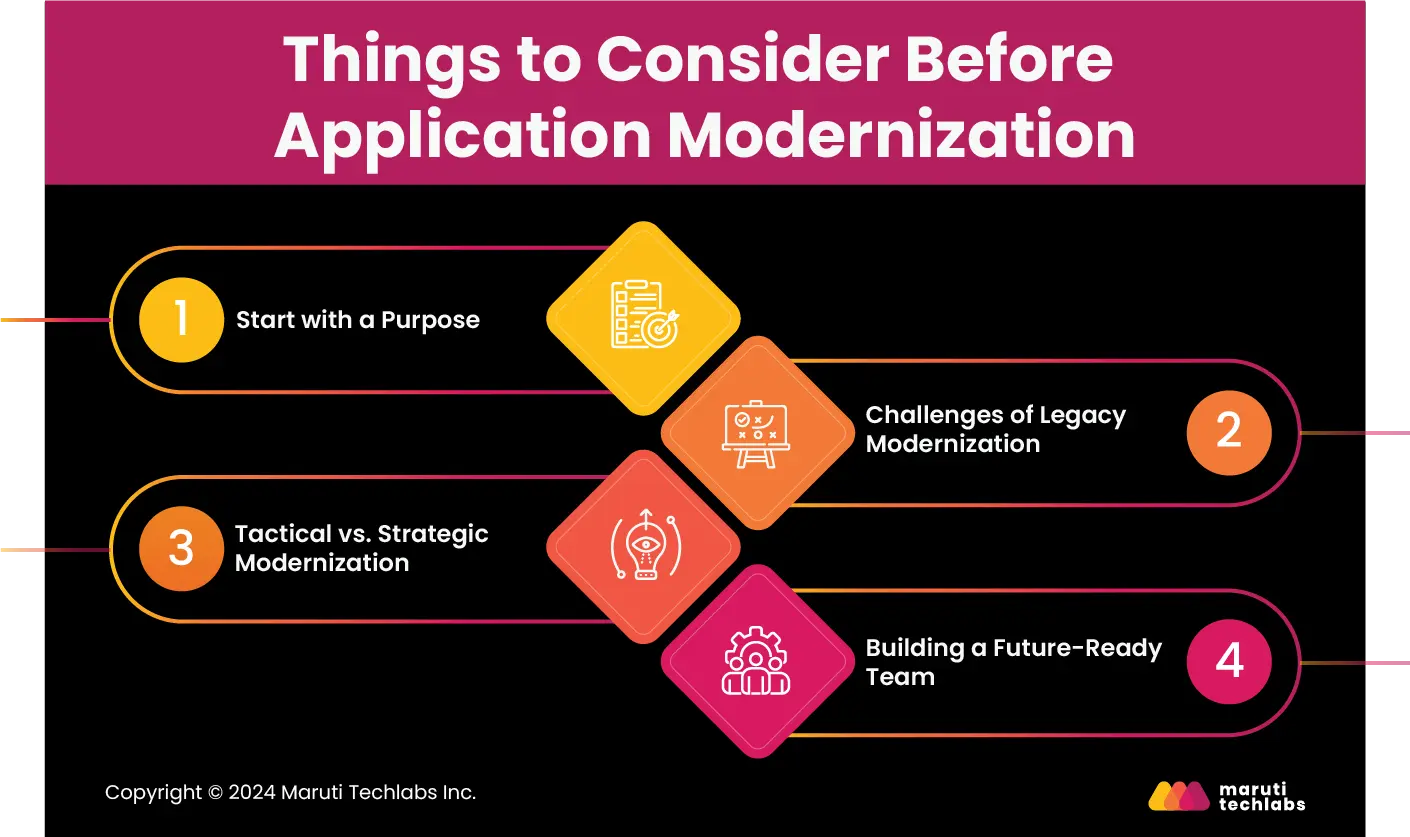
When contemplating application modernization, it's beneficial to start with the question, "Why?" This is a pivotal point for thoroughly examining current obstacles or potential advantages that might necessitate modernization for your application.
Consider these questions to figure out if your applications need modernization:
Addressing these questions can help you assess if modernizing the applications would benefit the business.
Despite the growing acceptance of contemporary solutions, numerous large-scale companies still depend on antiquated methodologies. Around 66% of enterprises still use legacy apps to power core operations, and 60% use them for customer-facing processes. This shows that although modernization has gained traction recently, a few obstacles act as barriers. To identify potential problem areas and mitigate the impact of challenges, one must contemplate a few factors:
Using both tactical and strategic methods simultaneously is essential for successful modernization in your organization.
A tactical method covers making small adjustments to your current systems or processes to improve them in the short term. This method focuses on immediate problem-solving and maximizing Return On Investment (ROI).
Adopting a strategic method is beneficial in the long run, as the organization’s overall growth is more important than a faster ROI. Moreover, by creating a transition plan with your modernization service provider, you can make well-informed decisions about the approach that best fits your project needs.
The training of employees is the key to the complete utilization of the legacy modernization initiatives:
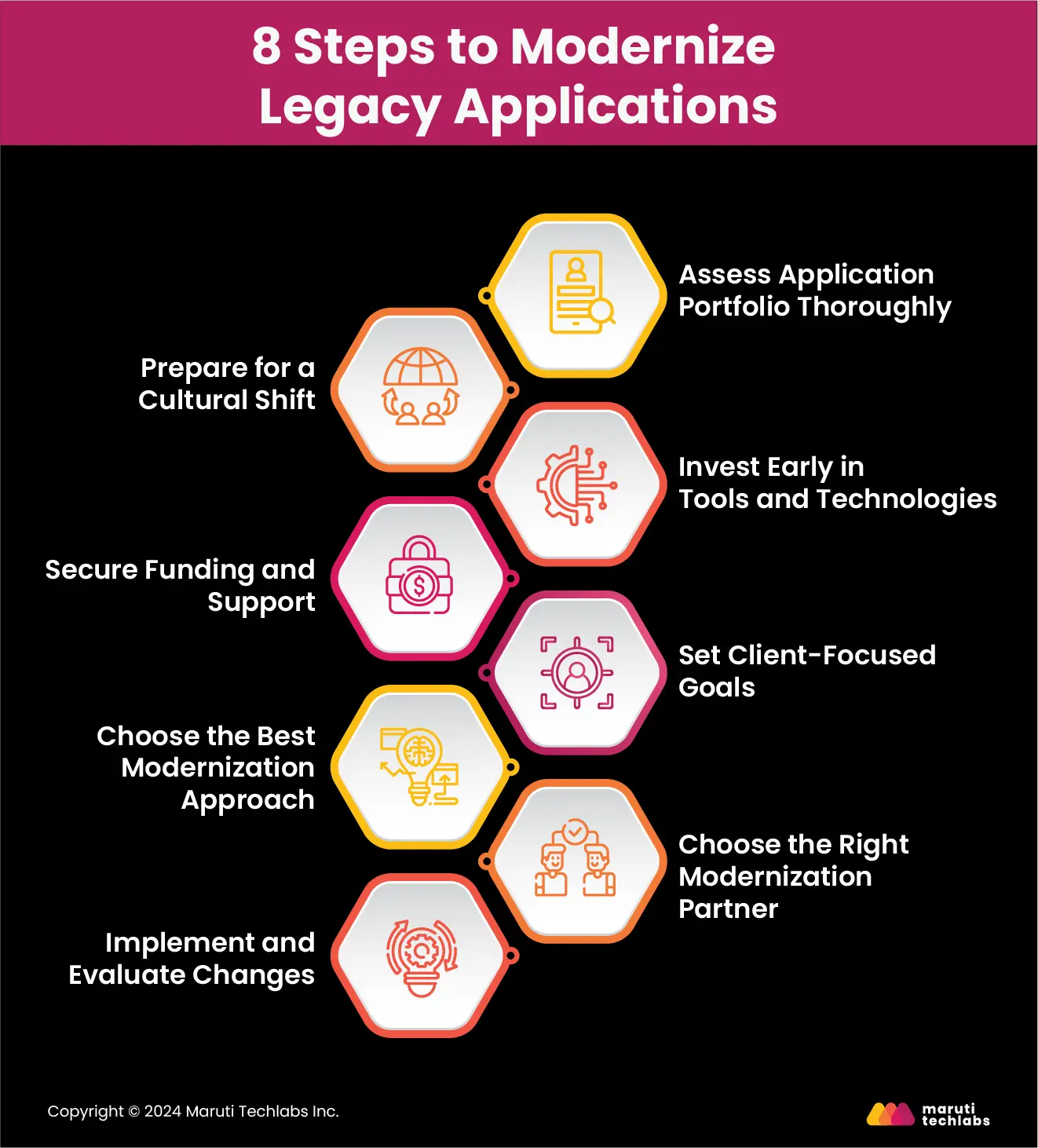
Every application modernization project might encounter challenges, which, if neglected, can result in costly mistakes and delays. The image below highlights questions that aid in pinpointing the necessary funds or resources, the competencies to execute the project, and the intricacy of implementing technologies. Consequently, you can mitigate the risks and attain optimal value from your modernization endeavor:
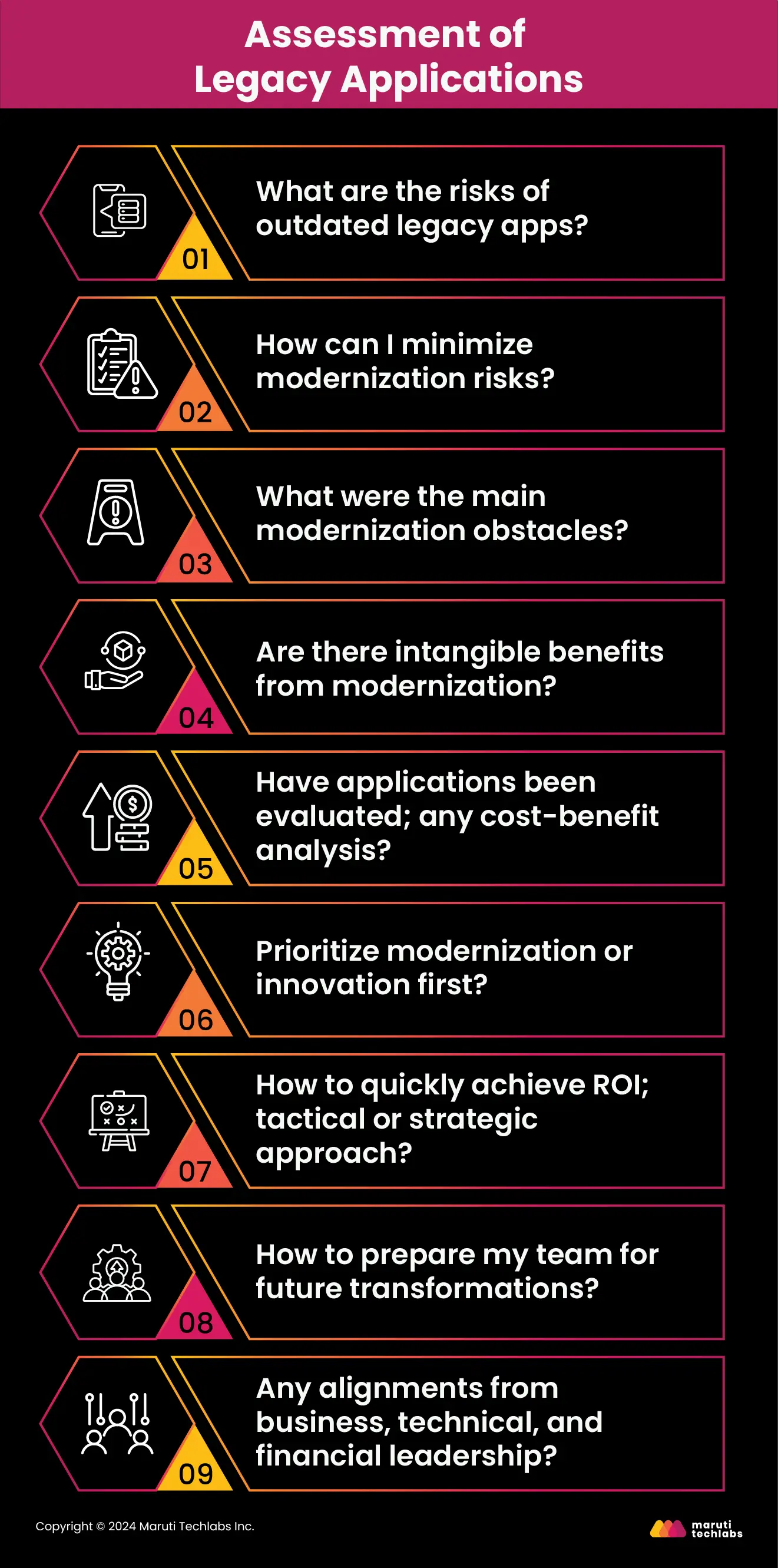
Applications that fail to satisfy current business standards in terms of – value, objectives, and flexibility should be modernized. Moreover, if indications suggest the necessity for modernization, such as using intricate technology or compromised security, conformity, assistance, and scalability, it's time to make a move.
Modernization causes a substantial shift in organizational culture, as employees are used to specific technologies and tools. The sudden transition to new technologies and workflows might affect their sense of security and stability. Convincing leadership teams about the necessity of initiating modernization projects and the associated expenses is also important because they communicate their vision for transformation to employees.
Employee engagement can be facilitated through various strategies, such as:
An AI-driven solution can help decision-makers analyze and streamline actual complexity metrics. With such a data-centric approach, organizational leaders can plan perfectly.
For this, you need to -
You need to obtain executive support to fund the project. With updated data, the budget for the modernization effort will be easier to estimate.
However, financing the application modernization differs from traditional IT budgeting, especially for organizations dependent only on monolithic or legacy applications. Traditional IT budgeting requires fixed amounts with fewer variations from year to year, but modernization requires a higher degree of uncertainty that must be considered when budgeting.
Therefore, it is important to calculate the return on investment (ROI) and total cost of ownership (TCO) to showcase the value the modernization project will bring to the organization.
After pinpointing the most vital business-critical applications, you can investigate how to enhance their efficiency, dependability, and expandability through modernization. You need to check modernization's effect on customer loyalty, market position, profits, etc. This will help you set clear and achievable IT and business goals.
It is essential to understand the 7 R's approaches to legacy modernization, which differ based on implementation, impact on the system, and associated risks. You can pick one or more that suit your current setup, budget, and long-term plans:
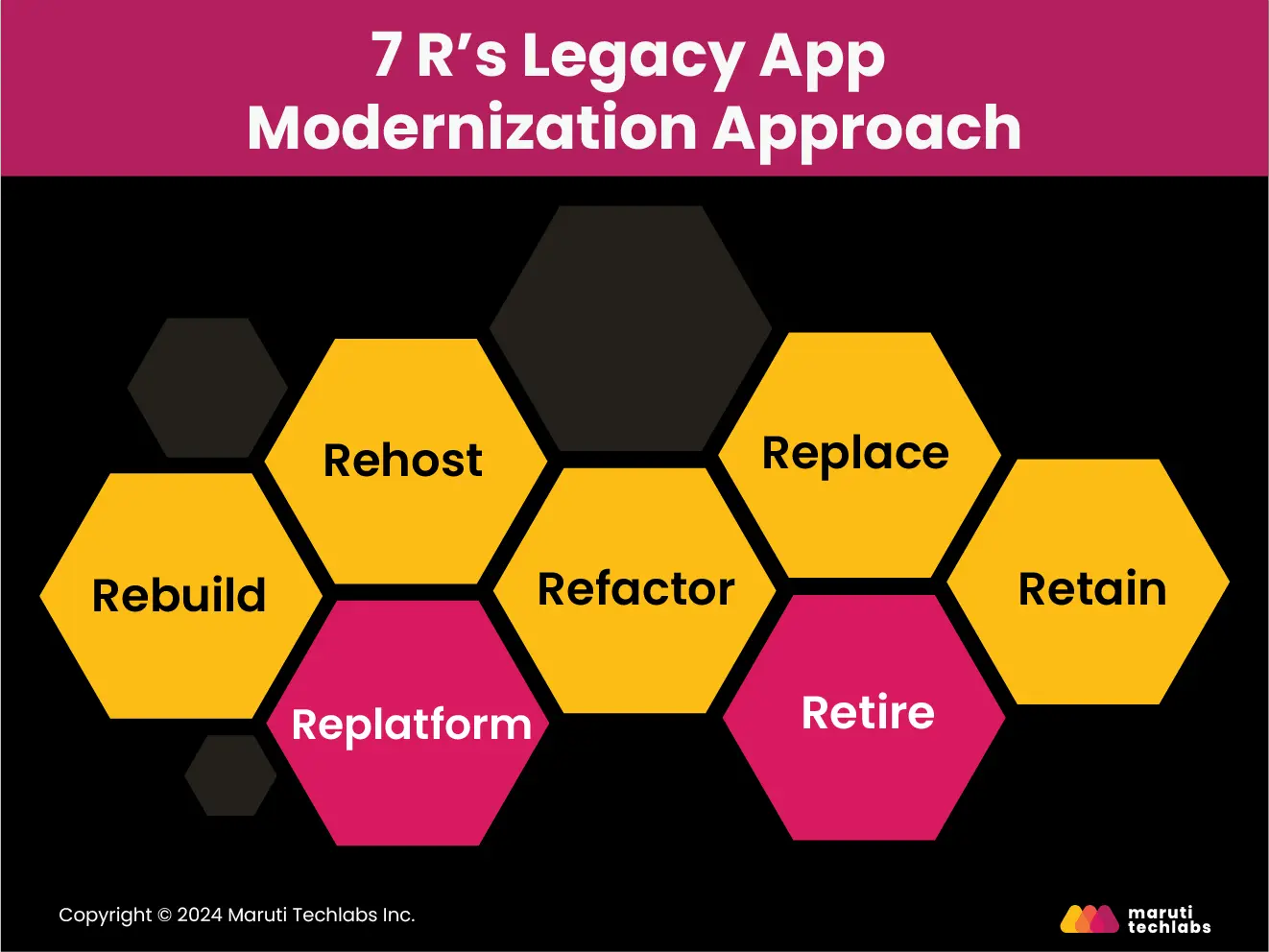
Rebuilding involves extensive DevOps practices and technologies like APIs, microservices, containers, etc. While other methods serve as steps toward complete modernization for many organizations, rebuilding transforms old processes into fully integrated cloud-native environments.
In the rehosting approach, old systems are moved to a new environment without changing their code or functionalities. Organizations can maintain their investments in old processes by rehosting and benefit from cloud infrastructure.
Also known as the 'lift and shift' method, rehosting is a preferred cloud migration best practice that allows for cloud adoption without redesigning systems. However, this modernization approach does not fully utilize all cloud-native tools.
Refactoring is typically used in hybrid environments, where some elements of legacy systems are enhanced for better performance. It usually entails modifying the backend components without changing the front end or functionalities.
Many organizations opt for refactoring because it's a less disruptive method than a total overhaul. It is supposed to be the preferred method since organizations will have time to study each app component and select the most appropriate platform.
Replacing involves eliminating the present system and replacing it with a new one to improve business processes. The main challenge here is ensuring a smooth transition of the existing data into the new system to avoid disruptions.
Retaining is a rare scenario in which an enterprise decides to maintain its environment without making any changes and lets its solutions operate as they are. For IT leaders, maintaining a legacy system is a significant decision. Organizations must have a long-term strategy to ensure the smooth operation of all app components.
As the name suggests, re-platforming involves moving an existing legacy system entirely to a different platform. While the app's features remain the same, the app components are moved to a new platform with minimal coding changes.
This offers improved performance with minimal infrastructure costs for the organization.
Retiring involves completely discontinuing the existing system and transitioning users to an alternate system that is already operational. Retiring old systems often requires a complete redesign of processes to address any gaps in operations.
CTOs and IT leaders must carefully evaluate the pros and cons of each tech decision. They must assess business needs against modernization benefits and choose the appropriate approach.
Legacy update is a lengthy, costly, and daunting procedure, but a stable organization within research and development and at the executive level can ensure the project's success.
Deciding who will fulfill the specific roles needed to implement the strategy depends on the project’s unique needs. Usually, chief architects are in charge of the process, and top-level executives aid them. Other roles involved in implementing these steps are financial backers, project overseers, tech experts, implementation leaders, and specialists in security and compliance.
Nevertheless, an organization's main focus is not just on application modernization, the internal teams may not have the right skills for the new environment and the overall transformation.
That's why one has to find an old-school modernizing partner who can focus on tasks, reduce confusion, and steer the effort toward cherished goals.
Regularly monitoring applications and infrastructure enhances software delivery performance. Hence, you need to view it as an ongoing modernization process to prevent updated applications from getting outdated again.
Consistent evaluation and measurement of outcomes are necessary when committed to continuous modernization. Following the steps outlined above, you'll already have key performance indicators to monitor your organization's progress toward its goals and objectives.
Here are a few results you can expect from legacy application modernization:
Implementing a well-defined strategy for application modernization is very important. While short-term decisions can solve the existing problems, the long-term strategy provides sustainable outcomes. With the right strategy, your business can achieve a flexible, scalable, and responsive application that can integrate with multiple business models.
This detailed analysis of legacy application modernization has covered its advantages, approaches, and outcomes. However, projects must be evaluated thoroughly, and best practices must be followed to avoid possible challenges and future risks. For expert guidance and assistance, check out our enterprise application modernization services and discover more about our offerings.
To assist you further, we've compiled a checklist that guides you through the modernization journey:
Our expert team at Maruti Techlabs will help you revitalize your legacy applications, ensuring they meet today's demands and tomorrow's challenges. Contact us today to start your modernization journey and take the first step toward a more agile and innovative future!
Some real-world examples of legacy systems are:
The main difference between modern and legacy applications is that the latter was not designed with automation as the primary goal, so they do not have the latest features, such as APIs and automated workflows. On the other hand, modern applications are equipped with automation capabilities, making their usage less customized and tested. They also allow better integration with other systems and devices that may be lacking in the old applications.
The 7 Rs of AWS Migration are rehost, relocate, replatform, refactor, repurchase, retire, and retain. These seven techniques or approaches have been designed to help organizations strategize, implement, and optimize their migration projects. These approaches help decide how to move apps and data from in-house systems to the cloud.
